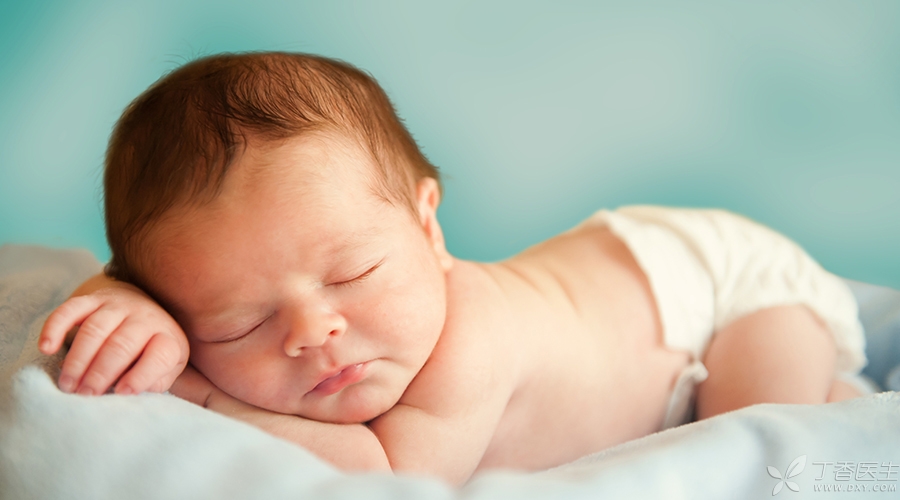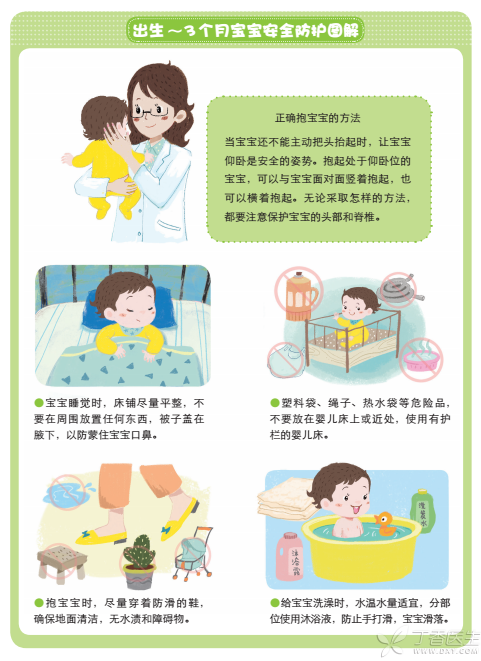
The baby grows up day by day and all aspects are developing little by little. They explore the world in their own way, but they do not know that the danger is around them. At this time, they need their parents to know more about safety precautions and be truly prepared for emergencies.
There are many potential safety hazards,
- The baby sleeps on his stomach or side, which is likely to cause asphyxia due to mouth and nose blockage. After lying down and feeding at night, the mother fell asleep, which may cause galactorrhea and blockage of nose and mouth. Holding the baby with hot drink and hot rice in hand, accidentally scalding the baby; The baby fell from the rocking chair, crib and diaper changing table. When holding the baby, the caretaker slipped and the older child threw objects, etc.
What should babies under three months pay attention to?
Step 1 Protect the spine
The spine of the newborn cannot support the head and body yet. When holding the baby, you should hold the baby in your arms with both hands and hold the baby’s head, neck, trunk and buttocks, so that the baby’s upper limbs bend in front of the chest and the lower limbs are frog legs, instead of the upper limbs being backed behind and the lower limbs stretching straight.
2. Prevent asphyxia caused by nasal blockage
The newborn’s breathing is very shallow, even a small handkerchief may affect his breathing, and the baby will not remove the objects covered on his face with his hands.
Therefore, nothing can be placed around the baby, such as plush toys, too soft bedding, small pillows or towels, thermos bottles, water basins filled with water, ropes and other dangerous articles, especially plastic films, and try not to let long-haired pets approach the sleeping baby. Be sure to put the baby in the crib to sleep and pull up and buckle the bed railings.
- Turn the sheets under the mattress and lay them flat. The small quilt is covered under the baby’s armpit, not at the neck. When letting the baby exercise prone position, be sure to help the baby turn his head to one side so that his nose and mouth are fully exposed, and the parents’ sight cannot leave the baby for a second.
Before the baby cannot lie prone and look up for a long time, do not let the baby take the prone position or lateral position to sleep, so as not to block the respiratory tract and cause asphyxia.

3. Safety Details of Holding Baby
When holding the baby, never take dangerous objects with the other hand, such as hot water, knives and forks, hard paper, lit candles, etc., nor do you hold the baby to light gas, pour hot water or cook.
Do not put the baby in the back brace. It is recommended to put the baby in the front brace to ensure that the baby’s face can be seen at all times and breathing difficulties can be found in time. It is not recommended to hold the newborn with the help of the brace.
When carrying the baby around on the ground, make sure the ground is clean and free of water stains and obstacles. Once the foot slips or is caught by obstacles, due to the lack of protective support of the upper limbs, the fall will be very heavy, and even there is a danger of throwing the baby out.
The shoes worn should also be anti-skid with the feet and soles, especially when bathing the baby in the toilet, more attention should be paid to anti-skid.
Step 4 Prevent falling from high places
If there is a console at home to change diapers and dress your baby, you must pay attention to safety and never let your baby sleep on the console.
At present, many families use mother-child beds for the convenience of breast feeding. There will be a gap between mother-child beds. Special attention should be paid to the safety of the baby when moving to prevent the baby from falling into the gap between the two beds.
5. Safety Details for Bathing Baby
- Before bathing the baby, Make sure your baby is always in sight, If you want to get something out of the bathroom, Also be sure to wrap the baby in a bath towel and hold it in your arms before picking it up. Put the bathtub on the ground, Squatting or sitting on a small stool to bathe the baby, Do not put the bath tub on the console or high table, In case the baby falls from a height. Now there are a lot of bath products, There are various bath aids, Such as bath bed, bath net, bath stool, There are also a wide variety of water toys. When using these bath aids, Be sure to buy safety products and be familiar with product safety warnings and safe use methods. The water level in the bathtub is just right to the baby’s thigh. If hot water is added to the bathtub, Be sure to take the baby away from the bathtub, Never put hot water directly. If you use a shower, Make sure the water heater switch is off, And the water temperature is constant. After applying bath lotion or soap, The skin will be very smooth, It’s easy to miss the baby. So, Do not rub bath lotion or soap all over your body at once, To wipe in sections, Make sure there is no soap foam on the part you are grasping. After the baby comes out of the water, Immediately put it on the towel and wrap the baby up. Dry your head. If your baby’s skin is dry, Within 3 minutes after the water is discharged, Apply baby moisturizer or cream all over your body. If you want to touch your baby, Pour the lotion into your palm, After rubbing the palms together, he began to touch the baby. When the baby is exposed for touching, We must ensure that the ambient temperature is around 24 ℃, And observe whether the baby breathes evenly, whether the lips are ruddy, and whether the body skin color is normal. Once the baby is found to be shortness of breath, purple lips or skin hair (uneven skin color, red and white, flowers), please immediately stop touching and wrap it with a dry towel. Do not feed the baby immediately after bathing, so as not to cause galactorrhea or vomiting.
